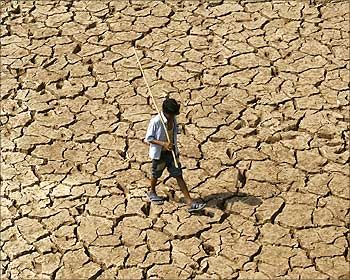A critical differentiating factor seems to be the interpretation of El Nino and its impact during the four-month southwest monsoon that starts from June, notes Sanjeeb Mukherjee
 The India Meteorological Department on Wednesday forecast that the southwest monsoon this year will be below normal at 93 per cent of the Long Period Average, barely days after another weather forecasting agency, Skymet, said rains would be normal at 102 per cent of the LPA, both with a model error of 4-5 per cent.
The India Meteorological Department on Wednesday forecast that the southwest monsoon this year will be below normal at 93 per cent of the Long Period Average, barely days after another weather forecasting agency, Skymet, said rains would be normal at 102 per cent of the LPA, both with a model error of 4-5 per cent.
So, IMD’s forecast is a good nine percentage points less than that of Skymet, the latter stopping two percentage points short of classifying the rains as being above normal.
LPA is the average rainfall the country received from 1951 to 2000 during the June to September southwest monsoon season and that stood at 89 centimetres.
The private weather forecaster went a step further and said rainfall in all the four months has a more than 50 per cent chance of being normal.
IMD will come out with its month-wise and region-wise forecast in June.
So, what makes the forecast by India’s two leading agencies differ so widely?
A critical differentiating factor seems to be the interpretation of El Nino and its impact during the four-month southwest monsoon that starts from June.
Skymet said El Nino might not have an impact on India’s southwest monsoon, as was the case in 2014, when a borderline El Nino was seen to have impacted the monsoon in the early part of the season.
However, IMD differs; it said El Nino conditions would persist during India’s southwest monsoon in 2015, one of the factors which has made their’s a below-normal forecast.
“Our analysis shows that El Niño intensity, measured in the form of temperature anomaly, will start tapering off as the actual season starts from June and, hence, this won’t have an impact on the southwest rains,” G P Sharma, vice-president, meteorology, at Skymet Weather Services, told Business Standard.
He said between February and April, the El Nino intensity was around 0.7 per cent and, thereafter, it will fade off and go down.
“We stand by our forecast and it has happened in the past as well that despite El Nino, the rains have been normal,” Sharma said.
D S Pai, the director of Long Range Forecast at IMD and one of the main scientists behind the monsoon forecast, however, feels most global models are showing that El Nino conditions will prevail during the four-month monsoon season.
Image: A man walks through the parched banks of Sukhana Lake in Chandigarh on May 19, 2009. Photographs: Ajay Verma/Reuters











